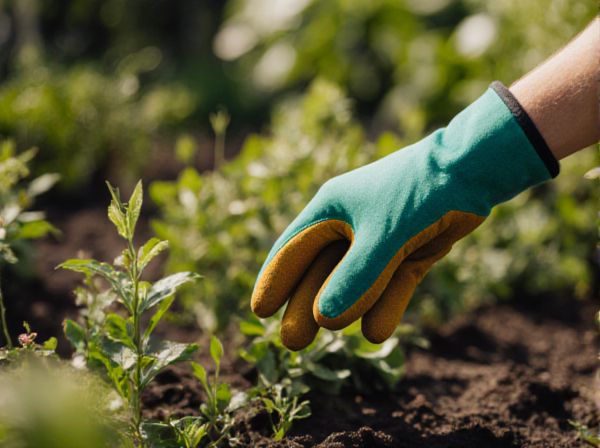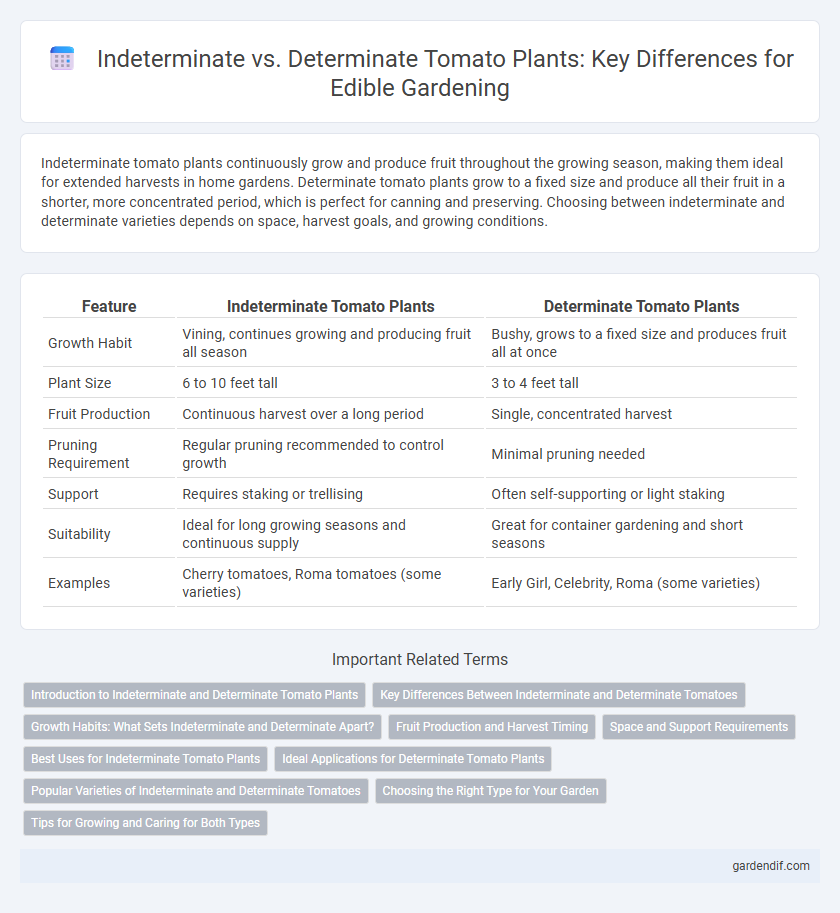
Indeterminate vs Determinate tomato plants Illustration
Indeterminate tomato plants continuously grow and produce fruit throughout the growing season, making them ideal for extended harvests in home gardens. Determinate tomato plants grow to a fixed size and produce all their fruit in a shorter, more concentrated period, which is perfect for canning and preserving. Choosing between indeterminate and determinate varieties depends on space, harvest goals, and growing conditions.
Table of Comparison
| Feature | Indeterminate Tomato Plants | Determinate Tomato Plants |
|---|---|---|
| Growth Habit | Vining, continues growing and producing fruit all season | Bushy, grows to a fixed size and produces fruit all at once |
| Plant Size | 6 to 10 feet tall | 3 to 4 feet tall |
| Fruit Production | Continuous harvest over a long period | Single, concentrated harvest |
| Pruning Requirement | Regular pruning recommended to control growth | Minimal pruning needed |
| Support | Requires staking or trellising | Often self-supporting or light staking |
| Suitability | Ideal for long growing seasons and continuous supply | Great for container gardening and short seasons |
| Examples | Cherry tomatoes, Roma tomatoes (some varieties) | Early Girl, Celebrity, Roma (some varieties) |
Introduction to Indeterminate and Determinate Tomato Plants
Indeterminate tomato plants grow continuously, producing fruit throughout the growing season with a vining habit that requires staking or support. Determinate tomato plants, also known as bush tomatoes, grow to a fixed mature size, setting fruit all at once before tapering off. Understanding the growth patterns of indeterminate and determinate tomatoes helps gardeners select the best variety for their space and harvest preferences.
Key Differences Between Indeterminate and Determinate Tomatoes
Indeterminate tomato plants continuously grow and produce fruit throughout the growing season, often reaching heights over six feet, while determinate varieties grow to a fixed size and produce fruit all at once. Indeterminate tomatoes require staking or trellising due to their vining habit, whereas determinate plants are bushier and more compact, making them ideal for small gardens or container growing. The extended harvest period of indeterminate tomatoes contrasts with the concentrated fruiting window of determinate types, influencing planting and harvesting strategies for home gardeners and commercial growers.
Growth Habits: What Sets Indeterminate and Determinate Apart?
Indeterminate tomato plants exhibit a vining growth habit, continuously producing new leaves and flowers throughout the growing season, which allows for an extended harvest period. Determinate tomato plants grow to a fixed mature size, with most fruit developing simultaneously, leading to a concentrated harvest period. This fundamental difference in growth habits influences pruning techniques, space requirements, and yield timing for gardeners and commercial growers.
Fruit Production and Harvest Timing
Indeterminate tomato plants produce fruit continuously throughout the growing season, allowing for a prolonged harvest period ideal for fresh consumption and extended supply. Determinate tomato plants yield fruit all at once, typically maturing within a shorter timeframe, making them suitable for canning or processing. Understanding the distinction in fruit production and harvest timing helps optimize cultivation strategies based on desired yield frequency and usage.
Space and Support Requirements
Indeterminate tomato plants require more vertical space and sturdy support systems such as cages or trellises due to their continuous growth and vine-like nature. Determinate tomato plants grow more compactly, typically needing less space and minimal staking because they reach a fixed mature size. Proper support maximizes air circulation and sunlight exposure, reducing disease risk and improving fruit production for both types.
Best Uses for Indeterminate Tomato Plants
Indeterminate tomato plants are ideal for gardeners seeking a continuous harvest throughout the growing season, making them perfect for fresh eating, slicing, and salads where consistent tomato supply is desirable. Their vining growth habit supports larger fruit yields, which benefits processing for sauces, salsas, and canning over several months. Indeterminate varieties thrive in trellised or cage systems, enhancing fruit quality and reducing disease, thus ensuring optimal flavor and texture for diverse culinary applications.
Ideal Applications for Determinate Tomato Plants
Determinate tomato plants are ideal for container gardening, small spaces, and commercial production where a concentrated harvest is preferred. These plants grow to a fixed size, setting fruit all at once, making them perfect for canning and preserving. Their compact growth habit reduces staking and pruning needs, optimizing space efficiency and harvest management.
Popular Varieties of Indeterminate and Determinate Tomatoes
Popular indeterminate tomato varieties include 'Beefsteak,' 'Cherry,' and 'Brandywine,' known for their continuous growth and fruit production throughout the growing season. Determinate varieties like 'Roma,' 'Celebrity,' and 'Heinz 2733' are prized for their bushier growth habit and concentrated fruit yield, ideal for container gardening and canning. Selecting between indeterminate and determinate tomatoes depends on space, harvest preferences, and culinary uses.
Choosing the Right Type for Your Garden
Indeterminate tomato plants grow continuously and produce fruit throughout the season, making them ideal for gardeners with space for vertical growth and extended harvest periods. Determinate tomato plants grow to a fixed size and produce fruit all at once, perfect for container gardening or canning purposes. Selecting the right type depends on your garden space, desired harvest time, and maintenance preferences.
Tips for Growing and Caring for Both Types
Indeterminate tomato plants require sturdy staking or cages to support their vigorous, sprawling growth and benefit from regular pruning to promote airflow and fruit production. Determinate varieties, which grow to a fixed size, thrive with less staking and need consistent watering to prevent cracking and ensure even ripening. Both types benefit from well-drained, nutrient-rich soil and mulching to maintain moisture and reduce weeds.
Indeterminate vs Determinate tomato plants Infographic

 gardendif.com
gardendif.com